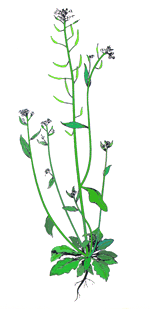Clarkia

Clarkia is a plant genus in the evening primrose family (onagraceae). This genus has become a well studied group of species in evolutionary biology and genetics. This genus of 41 species is almost entirely endemic to California with the exception of eight species, six that occur in various areas in the western United States including California (C. amoena, C. rhomboidea, C. gracilis, C. purpurea, C. epiloboides, and C. lassensis), one that occurs in the Pacific Northwest and excluding California (C. pulchella), and one that occurs in South America (Clarkia tenella). The first studies in Clarkia were cytogenetic examinations in the 1920’s. In the 1950’s, Harlan Lewis’ laboratory began examining this genus conducting taxanomic and systematic studies. He arranged the genus into 10 sections of 33 species. Today, the genus Clarkia has been expanded to 41 species divided into 11 sections. The Lewis lab also began to show that the genus as a whole exhibited chromosomal variation both within and between populations. After many years of study, Harlan Lewis proposed that the rapid speciation he observed in Clarkia was due to “catastrophic selection”, or extinction of marginal populations followed by colonization. One example of this sort of speciation can be witnessed in C. lingulata which differs from its progenitor, C. biloba australis, in lacking petal lobes and having an extra chromosome that is a rearrangement from C. biloba. C. lingulata is known to only occur in two small locations in the Merced River Valley of California and is at the end of the range of C. biloba.
Sweet Basil

 Arabidopsis
Arabidopsis
Arabidopsis thaliana is a small flowering plant that is widely used as a model organism in plant biology. Arabidopsis is a member of the mustard (Brassicaceae) family, which includes cultivated species such as cabbage and radish. Arabidopsis is not of major agronomic significance, but it offers important advantages for basic research in genetics and molecular biology.
Small genome (114.5 Mb/125 Mb total) has been sequenced in the year 2000 (AGI).
Extensive genetic and physical maps of all 5 chromosomes (MapViewer).
A rapid life cycle (about 6 weeks from germination to mature seed).
Prolific seed production and easy cultivation in restricted space.
Efficient transformation methods utilizing Agrobacterium tumefaciens.
A large number of mutant lines and genomic resources (Stock Centers).
Multinational research community of academic, government and industry laboratories.
Such advantages have made Arabidopsis a model organism for studies of the cellular and molecular biology of flowering plants. TAIR collects and makes available the information arising from these efforts.
Lycopersicon (Tomato)



